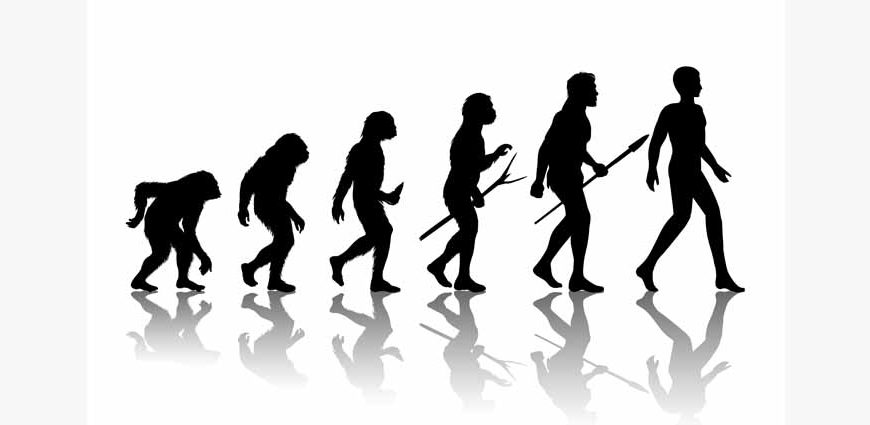All life on earth is related. For instance, young children’s ability to wiggle, breathe, cuddle, and grab objects is related to fish, reptiles, mammals, and apes. It may seem surprising, but the human body carries traces of its evolutionary journey, from the gills of early fish to the hands of primates that once swung through trees.
Teaching children about human evolution is not just about history—it’s about helping them understand who they are and where they come from. Parents play a crucial role in shaping this understanding. Instead of treating evolution as a complex scientific concept, parents can make it an exciting story of change, adaptation, and survival.
In this article, we will discuss the meaning and types of human evolution. What is Human Evolution? Interesting Facts About the History of Human Evolution
Human evolution is the lengthy process of change by which people originated from apelike ancestors. It involves the gradual development of traits and characteristics that distinguish modern humans from their early ancestors.
Here are some interesting facts about human evolution you can share with your little one:
- Human evolution began in Africa around 6-7 million years ago with the emergence of early hominins.
- Australopithecus, Homo habilis, Homo erectus, and Homo sapiens are the most important species of human revolution.
- Bipedalism is the term used to associate the beginning of the transition of apes to humans.
- Sahelanthropus tchadensis was the first species to start walking on two legs.
- Humans developed complex cultures, languages, and social structures alongside biological evolution.
- Homo sapiens, the species to which all modern humans belong, did not arise for around 5 million years after the first species was noticed.
The Timeline of Human Evolution
Now that we know interesting facts about the history of human evolution, let’s look at the timeline of human evolution closely.
- 55 million years ago
- 8 to 6 million years ago
- 5.8 million years ago
- 5.5 million years ago
- 4 million years ago
- 3.2 million years ago
- 2.7 million years ago
- 2.5 million years ago
- 2 million years ago
- 1.8 to 1.5 million years ago
- 1.6 million years ago
- 600,000 years ago
- 500,000 years ago
- 400,000 years ago
- 325,000 years ago
- 280,000 years ago
- 230,000 years ago
- 195,000 years ago
- 170,000 years ago
- 150,000 years ago
- 140,000 years ago
- 50,000 years ago
- 33,000 years ago
- 18,000 years ago
- 12,000 years ago
- 10,000 years ago
- 5,500 years ago
- 5,000 years ago
- 4,000 to 3,500 years ago
Primates evolved from their earliest forms.
The very first gorillas developed. Following this, the various chimpanzee and human lineages start to diverge from one another.
As the earliest known human ancestor is said to have started walking on two legs, bipedalism is introduced. Orrorin tugenensis, the species, is this ancestor.
The ape Ardipithecus has attributes similar to chimpanzees and gorillas. The habitat of this organism is forests.
Australopithecine primates, a kind of primate, appear. These primates walk on two hind legs and have brains that are equivalent in size to chimpanzees. The first known human ancestors to inhabit the Savannah were the Australopithecines.
Australopithecus afarensis lived in Hadar, Ethiopia, according to a specimen of its skeletal fossils found in East Africa in 1974. Since then, this specimen has been named Lucy.
At this period, Paranthropus, an ape species, inhabited meadows and woodlands. These primates used enormous jaws to chew on rough plant material and roots. This species vanished about 1.2 million years ago.
Homo habilis as a species first emerged. The face of this species is notably less projecting yet retains many characteristics of apes. During this period, hominids also started using stone tools, which they made by breaking stones more often. At this stage in the development of humans, certain hominids also started consuming a lot of meat. Due to the rise in meat-eating and the resulting increase in energy, hominids were able to grow their brains bigger.
In Africa, remains from this era of the ape Homo ergaster have been discovered. Compared to earlier species, this ape had a larger brain.
Asia is the location of the Homo erectus species. The earliest living examples of hunters and gatherers are primates. They were also the first in substantial numbers to travel outside of Africa. This species’ brain is much larger, with a capacity of about 1000 cm3.
1.6 million years ago is a crucial period in the human evolution timeline. Based on relics discovered in Kenya, it is thought that this period saw the earliest usage of fire. More sophisticated stone tools were also being made and utilised around this period. Most early humans continued to use these tools until about 100,000 years ago.
Homo Heidelbergensis is a species that now exists in Africa and Europe. The brain size of this species of monkeys was quite comparable to that of modern humans.
This is the period when the earliest signs of intentionally constructed shelters first appeared. The homes were made of wood. These homes were first discovered in Japan close to Chichibu.
The first people began using spears for hunting.
It is possible to date the first human footprints to 325,000 years ago. These footsteps are said to have been made by three individuals scaling a volcano in Italy.
More sophisticated stone blades and grinding stones were created. It is also one of the crucial periods in the human evolution timeline.
Neanderthals started to appear about this time. They may be found all throughout Europe, from Iran to Britain. When modern humans took over about 28,000 years ago, they finally died extinct.
Homo sapiens, or modern humans as we know them, initially appeared during this period. Human migration spans Asia and Europe. This is the time frame for the earliest indications of Homo sapiens remains. Two human skulls were among the bones that were discovered in Ethiopia. The average human brain’s volume at this period was 1350 cm3.
It is thought that Africa was home to the first direct progenitor of all modern humans around this period. This progenitor is known as Mitochondrial Eve by scientists.
Humans acquired the capacity for speech. Evidence suggests that around this period, Homo sapiens began to create a sophisticated system of symbolism and speech. Therefore, it is one of humans’ most essential periods of evolution.
Long-distance trading was first observed 140,000 years ago, according to fossil evidence.
Human culture begins to evolve significantly quicker rate at this stage in the timeline of human evolution. A few cultural shifts were adopting ritualistic burial practices, producing clothing from animal skin, and developing more clever, efficient hunting methods.
The oldest indications of cave art date around 33,000 years ago. At this period, Homo erectus became extinct entirely in Asia and was replaced by modern humans.
On the Indonesian island of Flores, there is a species of diminutive, prehistoric humans known as Homo Floresiensis. These prehistoric people are a little over a metre tall, and their brains are around the same size as chimpanzees’. But unlike chimps, these people did have sophisticated stone tools.
The Americas became home to modern people.
Agriculture started to grow and swiftly spread over the world. The development of the early settlements is related to the expansion of agriculture. It’s also believed that dogs were kept as pets for the first time 10,000 years ago.
The Bronze Age starts, and the Stone Age ends. As a new era began, humanity started using copper and tin tools instead of the stone ones they had previously used.
The oldest known example of writing comes from this era.
The Mesopotamian Ancient Sumerians created the world’s first civilisation.
7 Key Stages of Human Evolution
In the history of human evolution, there have been seven major phases of evolution that humans have undergone. These are:
- Dryopithecus
- Ramapithecus
- Australopithecus
- Homo Erectus
- Homo Sapiens Neanderthalensis
- Homo Sapiens
Dryopithecus is considered one of the earliest ancestors of both humans and apes. These primates lived in dense forests, moving through trees using their long arms and strong limbs. They were primarily herbivores, feeding on leaves and fruits. Fossils of Dryopithecus suggest that they had a body structure similar to modern apes, but with early signs of the evolutionary shift toward human-like traits.
Ramapithecus is believed to be among the first primates to exhibit hominid-like characteristics. Unlike Dryopithecus, they adapted to living in open grasslands instead of dense forests. This shift in habitat influenced their diet and movement, making them more reliant on walking upright for short distances. Their teeth and jaw structures suggest they consumed a mixed diet of fruits, seeds, and possibly meat.
Australopithecus marks a crucial stage in human evolution as one of the first known hominins to walk upright on two legs (bipedalism). They had smaller brains than modern humans but could use basic tools made from stones and bones. Their ability to walk on two legs allowed them to see over tall grasses and free up their hands for tool-making and carrying food.
Homo erectus is a significant evolutionary link between apes and modern humans. They had a larger brain than Australopithecus, a more upright posture, and the ability to make advanced tools. This species was also the first to use fire for cooking, warmth, and protection. They migrated out of Africa to Asia and Europe, adapting to various environments and developing primitive social structures.
Homo Sapiens Neanderthals were a subspecies of Homo sapiens that lived in Europe and parts of Asia. They were highly adapted to cold climates, with short, sturdy bodies and large noses to warm the air they breathed. Neanderthals were skilled hunters, used complex tools, and even showed early signs of cultural and emotional intelligence, such as burying their dead.
Homo sapiens are the final stage of human evolution and the species to which all modern humans belong. Our species continues to evolve biologically, culturally, and technologically. The development of agriculture, science, medicine, and digital technology has transformed how humans live, shaping the future of human civilisation.
Conclusion
Humans have come a long way, from monkeys walking on four limbs to humans walking on two hind limbs. As parents, it’s important to teach your kids about human evolution. It helps them understand how life on earth developed and learn the connection we share with all creatures. In this article, we have covered the stages, timelines and some interesting facts about human evolution. If you want to teach your kids more about humans and the human body system, check out our blog, Teaching Human Body Systems to Students. You can also visit the EuroKids Blog for more insight into your little one’s development, health, and learning. Don’t forget to check out EuroKids Preschools, the first step in your kid’s learning journey!
















